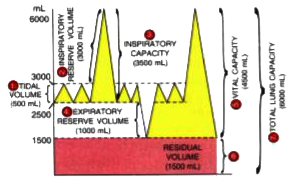During inspiration ,
The diaphragm gets raised and ribs get lowered
Both diaphragm and ribs get lowered
Ribs get raised and diaphragm get lowered
The diaphragm gets flattered and ribs get raised.
The correct Answer is:D
Step-by-Step Solution:
1. Understanding Inspiration:
- Inspiration refers to the process of inhaling oxygen-rich air into the lungs. This is a vital part of the respiratory cycle.
2. Role of Intercostal Muscles:
- The intercostal muscles are located between the ribs. During inspiration, these muscles contract, which causes the ribs to move outward and upward.
3. Diaphragm Movement:
- The diaphragm, a dome-shaped muscle at the base of the thoracic cavity, also plays a crucial role. During inhalation, the diaphragm contracts and flattens, moving downward.
4. Changes in Thoracic Cavity Volume:
- As the intercostal muscles pull the ribs outward and the diaphragm flattens, the volume of the thoracic cavity increases.
5. Pressure Changes:
- According to Boyle's Law, when the volume of a container increases, the pressure inside decreases. Therefore, as the thoracic cavity volume increases, the pressure inside the lungs decreases.
6. Air Flow into Lungs:
- The decrease in pressure inside the lungs compared to the atmospheric pressure causes air to flow into the lungs, completing the process of inspiration.
7. Correct Option Identification:
- Based on the above phenomena, we analyze the options provided:
- Option 1: Diaphragm gets raised and ribs lowered - Incorrect.
- Option 2: Both diaphragm and ribs get lowered - Incorrect.
- Option 3: Ribs get raised and diaphragm get lowered - Incorrect.
- Option 4: Diaphragm gets flattened and ribs get raised - Correct.
Final Answer:
During inspiration, the diaphragm gets flattened and the ribs get raised.
---
- Inspiration refers to the process of inhaling oxygen-rich air into the lungs. This is a vital part of the respiratory cycle.
- The intercostal muscles are located between the ribs. During inspiration, these muscles contract, which causes the ribs to move outward and upward.
- The diaphragm, a dome-shaped muscle at the base of the thoracic cavity, also plays a crucial role. During inhalation, the diaphragm contracts and flattens, moving downward.
- As the intercostal muscles pull the ribs outward and the diaphragm flattens, the volume of the thoracic cavity increases.
- According to Boyle's Law, when the volume of a container increases, the pressure inside decreases. Therefore, as the thoracic cavity volume increases, the pressure inside the lungs decreases.
- The decrease in pressure inside the lungs compared to the atmospheric pressure causes air to flow into the lungs, completing the process of inspiration.
- Based on the above phenomena, we analyze the options provided:
- Option 1: Diaphragm gets raised and ribs lowered - Incorrect.
- Option 2: Both diaphragm and ribs get lowered - Incorrect.
- Option 3: Ribs get raised and diaphragm get lowered - Incorrect.
- Option 4: Diaphragm gets flattened and ribs get raised - Correct.
During inspiration, the diaphragm gets flattened and the ribs get raised.
Topper's Solved these Questions
- BREATHING AND EXCHANGE OF GASES BOOK - CENGAGE BIOLOGY ENGLISHCHAPTER - BREATHING AND EXCHANGE OF GASES EXERCISE - Archives
15 Videos
- BIOMOLECULESBOOK - CENGAGE BIOLOGY ENGLISHCHAPTER - BIOMOLECULESEXERCISE - ARCHIVES
26 Videos
- CELL CYCLE AND CELL DIVISIONBOOK - CENGAGE BIOLOGY ENGLISHCHAPTER - CELL CYCLE AND CELL DIVISIONEXERCISE - ARCHIVES (Chose the corrct option):
21 Videos
Similar Questions
Which statements are correct ?
(A) During inspiration intra pulmonary pressure is less than the atmospheric pressure.
(B) During expiration diaphragm contract.
(C) Epiglottis is bony flap which prevent entry of food into the larynx.
(D) During forceful expiration abdominal muscles contract.
View SolutionThe volume of air in the lungs and the rate at which it is exchanged during inspiration and expiration was measured.
The following diagram shows a group of the lung volumes and capacities :

Study the diagram carefully and explain briefly the following:
(a) Tidal volume
(b) Inspiratory reserve volume
(c) Expiratory reserve volume
(d) Vital capacity
(e) Residual volume
View Solution
Knowledge Check
After deep inspiration, maximum expiration of lungs is called
Avital capacityBtotal lung capacityCinspiratory capacityDfunctional residual capacity
Disease occuring in the form of sudden attack of loud crowing inspiration in chlidren is
View SolutionHow do the following contribute in inspiration during breathing? (i) Ribs (ii) Diaphragm
View SolutionA: Normal expiration during quiet breathing, unlike
inspiration, is a passive process because on
muscular contractions are involved.
R: Normal expiration results from the elastic recoil
of the chest wall and lungs.
View SolutionExplain inspiration and expiration in the body.
View SolutionWhich respiratory muscles are used in inspiration.
View SolutionAn additional volume of air, a person can inspire by
a forceful inspiration is known as
View SolutionAfter deep inspiration, capacity of maximum expiration of lungs is called .......
View Solution
